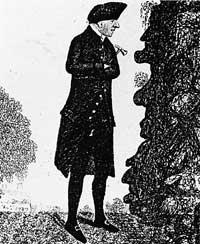James HUTTON (1726-1797), precursor of modern geology
March 26 is the most important event for geology, when Mr. James Hutton died in 1797. Although two centuries have passed since his death, many of the ideas he left us still use them to understand the Earth, since his work marked the pillars of modern geology.
James Hutton was born and died in the same city of Edinburgh. As a peasant, from youth he began to observe the soil and became interested in both erosive processes and the creation of new soil. He studied chemistry at the University of Edinburgh but soon began studying law. However, as science prefers law studies to law studies, it began to study medicine at the Sorbonne in Paris and at the Universities of Leyden (Holland). In the latter, in 1749 he wrote a doctoral thesis on blood trafficking entitled “Blood and circulation in the microcosm”.
However, he never worked as a doctor, as his wishes were in chemistry, agriculture and geology. Therefore, after studying medicine, he toured Britain and Europe to learn agricultural methods, mineralogy and geology. Finally, in 1754 he bought the farmhouse in Berwickshire, where he settled. His chemistry business went well, making enough money to live well and devote himself exclusively to his scientific responsibilities.
At the time of Hutton the Bible's interpretation of the age of the Earth, that is, that the Earth was about 6,000 years old, people believed blindly. Scientists of the time also thought the same and therefore believed that sedimentary rocks were due to the Universal Flood. At Hutton, however, the same was not considered. Moreover, this scientist rejected traditional Christianity and maintained that God did not participate in natural processes.

Hutton made numerous geological observations, representing them on paper and with great precision. The fruit of this work, several ideas, hypotheses and theory, summarized them in the book entitled “Theory of the Earth, with tests and images” in 1795. With the ideas contained in the book, Hutton banished long-abandoned Aristotelian thought on Earth and time, which was fashionable in the Renaissance. Moreover, one of the main contributions of this book is to explain the Rock Cycle and the Principle of Uniformitarianism or Actualism. This principle indicates that the geological processes currently operating had already acted before without catastrophic incidents. Thus, the origin of certain geological elements can be understood through processes in which we are currently working progressively. The prevalence of catastrophic scientists and uniformitarianism were not fully accepted by the conviction that to explain certain geological elements catastrophic facts were needed, so there has not been enough time to slowly create geological constructions.
On the other hand, Hutton explained that the Surface was eroded and regenerated with a gradual and constant process, this being that of the Rock Cycles. In the words of the Scottish scientist, the process begins with the deposition of lumps that occur in the marine sand, followed by compaction by water and weights of accumulated sediments forming rock. Due to volcanic activities in the interior of the land, the rocks of the coastal area go up passing outdoors and being exposed to erosive agents, starting again the cycle and constantly repeating. Since each cycle is very long, the Earth would have no beginning or end.
This idea recovers Aristotle's theories and drives them scientifically. In any case, Hutton's vision is Bulcanist or Plutonist, which is known by the two names, and was condemned by most scientists of the time, as his uniformed ideas clashed with the catastrophic ideas of that time. However, with the passage of time, after joining the contributions of catastrophic ideas, the Principle of Uniformitarianism was imposed among terrestrial scientists, recognition that allowed the development of modern geology.
Summarizing this, we want to underline that Hutton's importance in geology is similar to that of Darwin in biology and Newton in physics. As a culmination, in the above-mentioned book, Hutton wrote about the age of the Earth: “We find no indication of a beginning or an end.”





